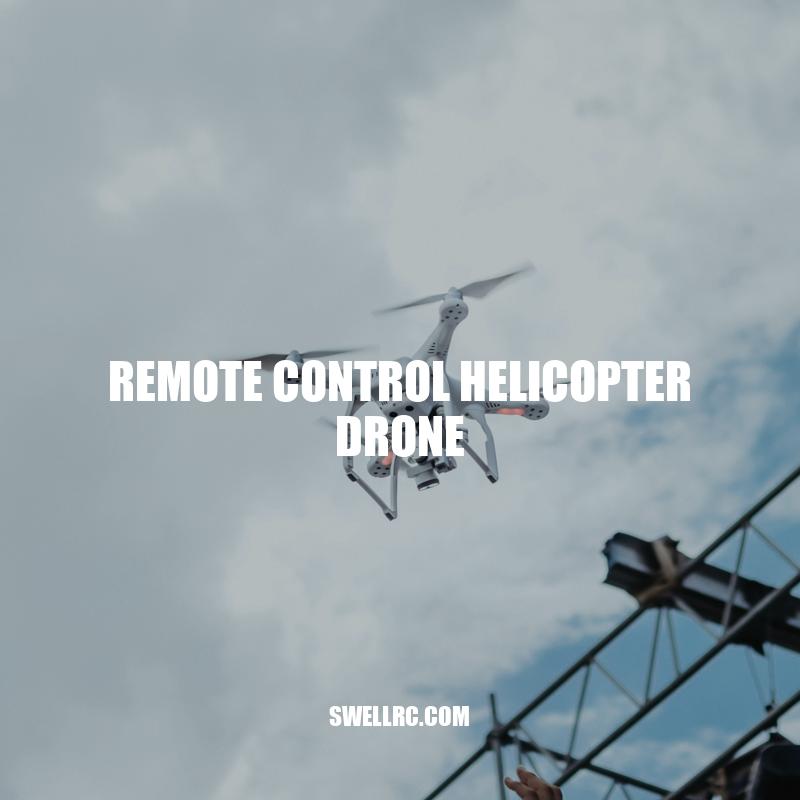Title: Remote Control Helicopter Drones: Features, Advances, Safety and Uses
Remote control helicopter drones have gained immense popularity in recent years, captivating millions worldwide with their ability to capture stunning aerial footage, perform tricks, and simply fly just for fun. A remote control helicopter drone, also known as a quadcopter, is a type of multirotor unmanned aerial vehicle that is controlled by a remote device. These aerial vehicles have become more accessible to consumers with the use of advanced technology, making them smaller, cheaper, and easier to operate. Helicopter drones are versatile in their use, making them appealing to both recreational and professional sectors. They come in various sizes, ranging from palm-sized to large commercial quadcopters used for surveillance and mapping. The technology behind these drones has evolved significantly, resulting in advanced features and capabilities that offer a remarkable flying experience. In this article, we will delve into the remote control helicopter drone world, including its features, technological advances, safety concerns, practical uses, and leisurely pursuits.
Key Features of Remote Control Helicopter Drones
Remote control helicopter drones present several impressive features that have made them attractive to recreational and professional drone operators. Here are some of the key features of these fascinating aerial vehicles:
- Agility and Precision: Remote control helicopter drones can fly in any direction and maneuver in tight spaces, making them ideal for aerial photography and videography.
- Stability: These quadcopters have the ability to hover in place with high accuracy and remain stable despite wind resistance as they fly.
- Camera: The drones’ camera has advanced capabilities including the ability to capture high-resolution images and videos and autofocus on targets.
- Controls: Helicopter drone remote controllers feature clear, easy-to-use displays, and programmable settings that allow users to customize their flying experience.
- Battery: Some models of helicopter drones feature removable and rechargeable batteries that offer users more flying time.
- GPS: Helicopter drones that come with GPS capability allow users to set and track flight paths automatically.
The features listed above are not exhaustive; they describe the general components that most remote control helicopter drones have. Depending on the model purchased or the drone’s intended use, these features may vary. For instance, some drone cameras come with 4K ultra-high-definition capabilities, while some remote controllers feature built-in screens. Nonetheless, most helicopter drones offer these features as they are fundamental requirements for an excellent aerial experience and reliability in their use. If you’re interested in purchasing a helicopter drone, online websites like Amazon, DJI, and Best Buy provide a range of models in various sizes and functionalities, making the selection easier for you.
What are the features of remote control helicopter?
Remote control helicopters have various features that make them popular among hobbyists and enthusiasts. Some of the notable features include:
- Capability of flying in different directions, including forward, backward, up, and down
- Ability to hover in one place
- Option to perform various tricks and stunts
- Adjustable speed settings for different flight experiences
- LED lights for night flying
- Control range of up to several hundred feet
Remote control helicopters are available in different sizes, designs, and prices. Some popular brands that offer these flying machines include Syma, Holy Stone, and Blade. Those interested in purchasing a remote control helicopter may explore online shopping platforms such as Amazon or specialized hobby shops such as Horizon Hobby.
| Brand | Size | Price Range |
|---|---|---|
| Syma | Small to Medium | $20-$200 |
| Holy Stone | Small to Medium | $30-$200 |
| Blade | Small to Large | $100-$500 |
Advances in Remote Control Flight Technology for Helicopter Drones
The increasing popularity of remote control helicopter drones has been accompanied by significant advances in their flight technology. These advances enable drone users to operate their quadcopters with more precision, stability, and flexibility. Here are some of the key advances in remote control flight technology for helicopter drones:
- Cameras and Sensors: The technological advances in cameras and sensors in helicopter drones have provided a more accurate and stable flight experience for operators. Some models have obstacle-avoidance capabilities, remote focus, and zoom control.
- Battery Technology: Modern drone batteries have advanced long-life and quicker recharge capabilities. The batteries offer advanced energy management and real-time monitoring capabilities to extend drone flight time and reduce wear and tear on the quadcopter components.
- Wireless Communication: Helicopter drones can communicate wirelessly with their pilots and ground stations to send data during flight. This feature enables real-time data transmission, such as live streaming video and telemetry data about the quadcopter’s performance.
- Flying Performance: With advances in flight software, helicopters can be flown more precisely and accurately than ever before. This means they can be operated at higher speeds, carry heavier payloads and maneuver in more complex environments.
- Drone Synergy: Helicopter drones can be used in conjunction with other drones to enhance their capabilities, including obstacle detection and avoidance, traffic monitoring, and security surveillance.
The table below summarizes some advances in remote control flight technology:
| Technology | Advances |
|---|---|
| Sensors | Remote focus and obstacle detection capabilities. |
| Battery technology | Long-life batteries with quick recharge capabilities and energy management. |
| Wireless communication | Real-time data transmission, such as live streaming video and telemetry data about the quadcopter’s performance. |
| Flying Performance | Faster speeds, heavier payloads, and precision flight capabilities. |
| Drone Synergy | Integrated systems with collaborative capabilities for improved performance. |
Thanks to these remarkable technological advances, remote control helicopter drones have become more accessible and more affordable than ever. Inexpensive drone models can be bought online through retailers like AliExpress, Target, and Best Buy, while high-end helicopter drones from companies like DJI, Autel Robotics, and Parrot offer more sophisticated functionality and quality.
What are some of the major advancements in drone technology?
Drones have come a long way since their first introduction, and significant advancements have occurred over the years. Here are some of the major advancements in drone technology:
- Improved Battery Life: Drones now have long-lasting batteries, allowing for extensive flight times and the ability to cover more distances.
- Obstacle Avoidance Technology: The latest drones come with sensors that help detect and avoid obstacles, making them safer to fly and reducing the risk of collisions.
- Camera Technology: The cameras on drones have improved significantly, with higher resolutions, better image stabilization, and the ability to capture 360-degree footage.
- Autonomous Flying: Drones can now be programmed to fly autonomously, using GPS and other sensors to navigate and gather data.
- AI and Machine Learning: Drones are becoming smarter, with the ability to identify objects, patterns, and even people, making them useful for a range of applications including mapping, agriculture, and surveillance.
Some notable products that showcase these advancements in drone technology are the DJI Mavic 2 Pro, the Autel Robotics EVO II, and the Skydio 2. For more information and drone-related news, websites like DroneDJ and Drone Rush offer regular updates and product reviews.
Safety Concerns and Tips for Using Remote Control Helicopter Drones
Although remote control helicopter drones provide many benefits and are a joy to fly, there are safety concerns that operators must be aware of. Here are some of the most important safety tips to follow to ensure the safe use of your drone:
- Check the local regulations: Regulations for drone use vary from place to place, and it’s essential to familiarize yourself with these rules before using your drone.
- Keep Your Drone in Sight: Always keep your drone in sight when operating. This rule will help avoid collisions with other objects or people.
- Pre-Flight Checks: Conduct pre-flight checks and ensure that your drone’s firmware and hardware are up-to-date.
- Know Your Drone’s Flight Limits: Drones have limited battery life and can only fly for a certain period. Always know your drone’s battery life and its maximum elevation limit.
- Avoid Flying Your Drone in Rain or Fog: Avoid flying your drone in inclement weather, as it can reduce your visibility and affect the drone’s stability.
- Practice: Beginners should practice in safe and open areas to develop their flying skills before operating their drones for longer distances.
Also, several safety concerns must be considered when flying remote control helicopter drones, including:
- Privacy issues: Ensure to respect people’s privacy and avoid filming people without permission or in restricted areas.
- Disturbance: The noise and presence of drones can disturb people, animals, or other environmental elements in sensitive areas.
- Collisions: Drones can cause injuries and property damage if they collide with people, structures, or vehicles.
To address these concerns, drone manufacturers and retailers have created an array of resources and legal guides on safe drone use. Official websites such as the Federal Aviation Administration (FAA), in the United States, provide flight regulations, registration requirements and drone flying guidelines. Hobby groups and drone clubs also exist as supportive learning tools to pilot and understand the best safety practices for remote controlled drone hobbyists.
What are the safety features of a helicopter?
Safety features of a helicopter include:
- Emergency flotation systems to keep the helicopter afloat during emergency landings on water
- Cockpit voice and data recorders that can help investigators determine the cause of a crash
- Emergency locator transmitters that help rescuers locate a downed helicopter
- Crash-resistant fuel systems that reduce the risk of fire in the event of a crash
- Night-friendly lighting that enables pilots to fly in darkness
- Weather radar and avoidance systems to help pilots avoid bad weather
For more details, you can visit the Federal Aviation Administration (FAA) website or the helicopter manufacturers’ websites such as Bell Helicopter or Sikorsky. These websites provide comprehensive information on helicopter safety features and their development.
Fun and Leisure Activities with Remote Control Helicopter Drones
Remote control helicopter drones can provide hours of fun and entertainment for pilots and spectators alike. Here are some ideas on how to enjoy this fascinating technology to the fullest extent:
- Photography: Use your drone to capture stunning aerial pictures and videos of landscapes, events, or moments. There are inbuilt HD cameras that offer a stabilized view without shakiness.
- Aerial Races and Contests: Use your drone to participate in fun aerial races and contests with other drone owners. These challenges test speed, agility, and accuracy.
- Stunt Flying: Push your drone to its limits, performing loops, flips, and other stunts. A simple drone like the Syma S107G can be an excellent starting point for practicing and displaying acrobatics.
- Show and Tell: Use your drone to demonstrate your piloting skills at events, shows, and competitions such as the International Open held by the Academy of Model Aeronautics (AMA).
- Hobby Groups: Get involved in hobby groups or attend drone events for other enthusiasts who share your interest.
- Virtual Reality: With advancements in virtual reality, specialized goggles and headsets can be paired with your remote control helicopter drone camera. The goggles enable immersive first-person experience during your drone flight.
Although drone flying starts as a hobby or leisure activity, drone enthusiasts have also transformed the pastime into a profession. By filming aerial views of buildings or tracking the growth of crops and analyzing different terrain features by companies or scientific research institutes, professionals use remote controlled drone technology to revolutionize their industries.
Using high quality and long-lasting products can assist you to get the best out of your remote control helicopter drone. From spare batteries to after-sale services, retailers such as DJI, Blade, and Holy Stone offer a range of options that cater to both beginners and experts in drone-enthusiast culture.
What is the use of drone helicopter?
Drone helicopters are used for a variety of purposes including aerial photography and videography, surveying land, conducting search and rescue operations, delivering goods, and even spraying crops in agriculture. Some popular drone manufacturers include DJI, Parrot, and Yuneec. To learn more about drone technology and its uses, visit websites such as dronelifestyle.com or dji.com.
Practical Uses of Remote Control Helicopter Drones
While remote control helicopter drones are undoubtedly a fun hobby, they also have many practical applications across different industries. Here are some examples of how these drones are being used in professional settings:
- Search and Rescue: Remote control helicopter drones can quickly access hard-to-reach locations and provide high-definition footage in search and rescue operations. With thermal imaging cameras, they can locate and track missing persons or wildlife from a considerable height.
- Inspections: Professionals in architecture and construction employ drones to inspect infrastructure and buildings, identify cracks, gaps, or defects that may be difficult to detect during ground surveys. Also, drones are used for detailed land survey maps to analyze land usage or demography.
- Filming and Photography: In the media industry, drone filming provides broadcasters with a more comprehensive range of potential video and photographic subject matter. Drones offer impressive views from heights, angles, and directions that weren’t available with regular cameras.
- Agriculture: Drones equipped with high-quality cameras have revolutionized modern agriculture and farming. Farmers use drones for crop analysis, monitoring irrigation systems, or assessing potential damage or pest problems in crops, which help in identifying problems and solving them on time.
Many technological companies have released remote control helicopters with features optimized for specific professional needs. DJI Mavic 2 Enterprise is one such drone with a modular design that is made for professionals who require different modes of access in their field; such as spotlight mode for intense directional lighting or speaker mode to communicate with individuals or announce information. Other brands such as Yuneec or Syma have released rugged and high-performance models for military and commercial purposes. Therefore, before purchasing, one must research into which suits the operation’s needs first and foremost.
What can helicopters be used for?
Helicopters can be used for a variety of purposes, including but not limited to:
- Transportation of people and cargo, particularly in hard-to-reach areas or during emergency situations
- Search and rescue missions
- Military operations, such as transport of troops and equipment or reconnaissance
- Aerial photography and filming for movies, TV, and news
- Supporting firefighting efforts by dropping water or fire retardants on the affected area
If you are interested in learning more about helicopter usage, you can visit websites such as Helicopters Magazine or ForeFlight Helicopter. You can also browse through helicopter-related products on websites like HeliDirect, which offer a wide range of parts and accessories for hobbyists or professionals.
Conclusion
In conclusion, Remote Control Helicopter Drones aren’t just toys to play with, as they have many practical and professional applications. They’ve become a valuable asset in different fields such as agriculture, construction, media, and search and rescue operations. They provide an alternative solution to situations that are often dangerous for human beings and save lives in the process. However, we must be aware; the use of drones can be problematic if the right regulations are not in place. It’s essential to operate them responsibly by following the guidelines provided by the FAA and local laws to ensure the safety of people and wildlife.
With technological breakthroughs, the market continues to grow, and companies are finding more ways to improve drone capabilities. Thus, it is essential to keep updated on the latest technology trends. As drones become more popular, prices lower, and capabilities increase, it becomes more accessible to the general public. They are no longer limited to photographers, farmers, or military personnel but becoming a valuable asset for anyone who wants to have fun, learn, or explore with the benefits that come with owning a drone. With the right training and the applicable purchases, the possibilities of what one could achieve with a Remote Control Helicopter Drone are limitless.



